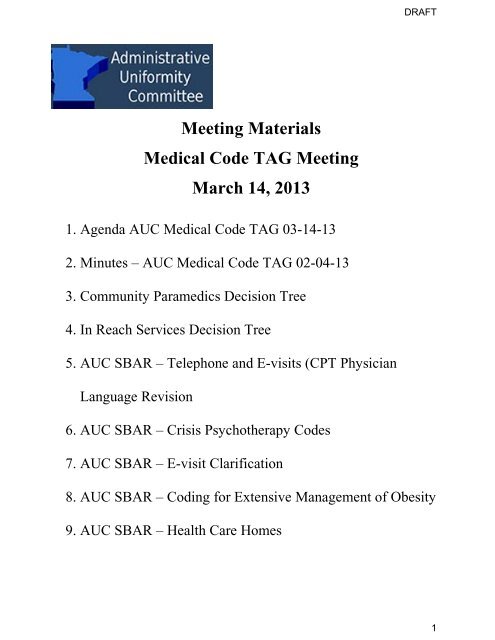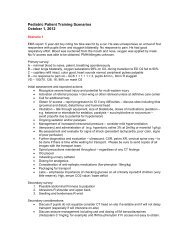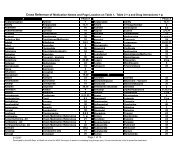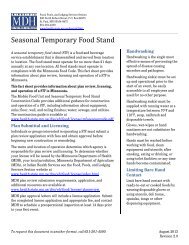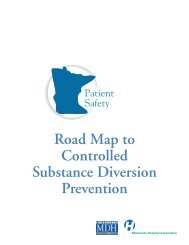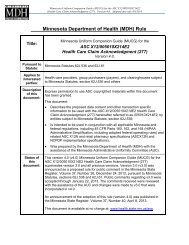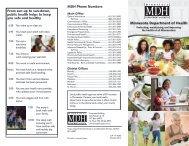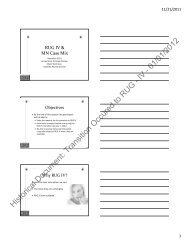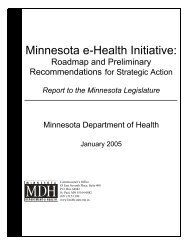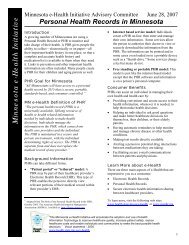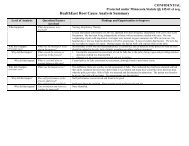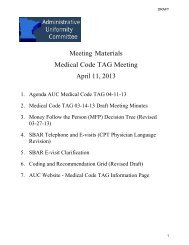AUC Medical Code TAG Meeting Materials 03-14-13 - Minnesota ...
AUC Medical Code TAG Meeting Materials 03-14-13 - Minnesota ...
AUC Medical Code TAG Meeting Materials 03-14-13 - Minnesota ...
You also want an ePaper? Increase the reach of your titles
YUMPU automatically turns print PDFs into web optimized ePapers that Google loves.
DRAFT<br />
<strong>Meeting</strong> <strong>Materials</strong><br />
<strong>Medical</strong> <strong>Code</strong> <strong>TAG</strong> <strong>Meeting</strong><br />
March <strong>14</strong>, 20<strong>13</strong><br />
[Type a quote from the document or the summary of an interesting point. You can<br />
1. Agenda <strong>AUC</strong> <strong>Medical</strong> <strong>Code</strong> <strong>TAG</strong> <strong>03</strong>-<strong>14</strong>-<strong>13</strong><br />
2. Minutes – <strong>AUC</strong> <strong>Medical</strong> <strong>Code</strong> <strong>TAG</strong> 02-04-<strong>13</strong><br />
3. Community Paramedics Decision Tree<br />
4. In Reach Services Decision Tree<br />
5. <strong>AUC</strong> SBAR – Telephone and E-visits (CPT Physician<br />
Language Revision<br />
6. <strong>AUC</strong> SBAR – Crisis Psychotherapy <strong>Code</strong>s<br />
7. <strong>AUC</strong> SBAR – E-visit Clarification<br />
8. <strong>AUC</strong> SBAR – Coding for Extensive Management of Obesity<br />
9. <strong>AUC</strong> SBAR – Health Care Homes<br />
1
DRAFT<br />
AGENDA – MEDICAL CODE TECHNICAL ADVISORY GROUP (MCT)<br />
Thursday, March <strong>14</strong>, 20<strong>13</strong><br />
9 a.m. to 12 p.m.<br />
Location: SOP, <strong>Minnesota</strong> conference room<br />
Teleconference Information:<br />
Call-in line: 1-605-475-5950<br />
Participant Access <strong>Code</strong>: 3372<strong>13</strong>#<br />
Callers are responsible for any<br />
long distance charges.<br />
1. Welcome and Introductions<br />
• Attendance tracking: Deb Sorg<br />
deb.a.sorg@healthpartners.com<br />
2. Review of Antitrust Statement<br />
Webex Information<br />
1. To start the webex session, go to:<br />
https://health-state-mn-ustraining.webex.com.<br />
2. Under “Attend a Session “click “Live Sessions”<br />
3. Click on the session for “<strong>AUC</strong> <strong>Medical</strong> <strong>Code</strong> <strong>TAG</strong>”<br />
4. Provide your name, email address, and the following<br />
password: Mct2010! (Note: the password must be typed in; it<br />
cannot be cut and pasted. The exclamation point is part of the<br />
password)<br />
5. Click “Join now”<br />
3. Review of last meeting’s minutes<br />
4. AAPC CEUs – De Krengel, Medica<br />
5/10/12 Minutes:<br />
De inquired about the process to evaluate the possibility for <strong>AUC</strong> attendees to earn AAPC CEUs for attending the monthly 3 hour meetings.<br />
Below is the response from the CUE Vendor Dept Rep at AAPC.<br />
A few questions, first are you affiliated/employed with the MN-<strong>AUC</strong>? To clarify the reason for this question is that we cannot do an approval for<br />
a company/organization without their knowledge. Another question is are these meetings free to anyone, is it a membership organization, or is<br />
their a fee to attend? This question will assist us in explaining the application process due to any possible fees assessed.<br />
Once we have these questions answered I will be able to provide you with specific information about the approval process. You can also review<br />
our guidelines and FAQ page at this link: http://www.aapc.com/CEUVendors/guidelines-for-ceu-approval.aspx<br />
ACTION: De will work with Joann Wolf and Carolyn Larson. Our mission, agenda example, and additional information will be submitted to the<br />
AAPC.<br />
7/12/12:<br />
ACTION: Carolyn Larson and De Krengel will complete application to provide information that this activity is not a vendor activity.<br />
8/9/12, 9/<strong>13</strong>/12, 10/11/12, 12/<strong>13</strong>/12:<br />
Per Carolyn Larson, the AAPC is still pushing for vendor status.<br />
ACTION: Carolyn Larson will work with Dave to include additional information and resubmit the request.<br />
1/10/<strong>13</strong>:<br />
Carolyn Larson reported that we should know by next month whether we are getting “vendor status”.<br />
2/<strong>14</strong>/<strong>13</strong>:<br />
Discussion postponed<br />
5. Community Paramedic Services – De Krengel, Medica<br />
7/12/12:<br />
De Krengel raised issue of community paramedic services –how are services to be coded.<br />
Discussion –<br />
Does the paramedic have to be enrolled as a provider?<br />
Does ambulance service bill for paramedic services? Who is billing?<br />
What can be billed? No actual ambulance service is billed.<br />
OPEN<br />
OPEN<br />
OPEN<br />
OPEN<br />
OPEN<br />
OPEN<br />
2
DRAFT<br />
Payers with public program members have to comply by 1/1/<strong>13</strong>.<br />
Do paramedics need taxonomy code?<br />
Medicare does not cover these services.<br />
Equivalent to home health type services.<br />
Try to fast track review of this issue due to 1/1/<strong>13</strong> implementation date.<br />
De will send Faith link to legislative requirements, Faith will forward to MCT.<br />
DHS will provide more information.<br />
ACTION: De will write SBAR.<br />
The following information was submitted by Judy Edwards post-meeting:<br />
Attached is an SBAR we received from De Krengel and forwarded to the <strong>AUC</strong> Executive Committee for its review and recommendation. The<br />
committee has reviewed and approved the SBAR to the <strong>Medical</strong> <strong>Code</strong> <strong>TAG</strong> for its review for applicable coding guidelines.<br />
At Dave’s request, I searched the Web to get some information about community paramedics and <strong>Minnesota</strong>’s program and legislation. Below<br />
are some of the sites I visited that you may find of interest. In addition to the links included in the SBAR, these web sites may provide answers<br />
to some of the questions asked at the last <strong>TAG</strong> meeting during the brief discussion.<br />
https://www.revisor.mn.gov/statutes/?id=<strong>14</strong>4E.28 (<strong>Minnesota</strong>’s EMS statutes)<br />
https://www.revisor.mn.gov/statutes/?id=256B.0625 (DHS statutes cited in new law regarding billable services by community paramedics)<br />
http://communityparamedic.org/ (<strong>Minnesota</strong>’s organization)<br />
http://www.emsworld.com/article/1<strong>03</strong>18789/minnesota-gets-its-community-paramedics<br />
http://minnesota.publicradio.org/collections/special/columns/ground-level/archive/2011/04/paramedics-take-on-expanded-healthcare-role-inrural-minnesota.shtml<br />
8/9/12:<br />
Discussion –<br />
Who is billing? The medical director from the ambulance service or eligible provider who performs the service will do the billing.<br />
What can be billed? No actual ambulance service is billed. Health assessment, chronic disease, vaccinations, collecting lab specimens,<br />
Do paramedics need taxonomy code? – Barb will check<br />
Discussion of community paramedics<br />
What do we know:<br />
Face to face element<br />
Professional claim only<br />
No travel/mileage<br />
No facility charges<br />
Will use code T1016<br />
Who’s the billing person?<br />
Ambulance medical director will determine scope of practice for each paramedic<br />
Each paramedic can have different scope of practice<br />
Community paramedics must be certified. There are three levels of expertise/certification<br />
Primary care provider consults with medical director to determine plan of care<br />
Has not been approved by Feds<br />
Effective date for community paramedic services is date approved by Feds (rather than July 1, 2012)<br />
Taxonomy will not be used<br />
What we don’t know:<br />
Who is the referring provider, primary care provider or medical director?<br />
Who is billing? How will the provider be distinctly identified?<br />
Is code T1016 appropriate?<br />
Is a modifier needed to differentiate between In-reach services or other case management services for T1016?<br />
Is this just for DHS?<br />
What types of services?<br />
How will vaccines, drugs, and supplies be billed?<br />
Are there services and/or supplies that will be billed outside of T1016?<br />
Do we need extra modifiers?<br />
Is medical director only provider who determine community paramedics scope of practice?<br />
ACTION: Open for additional discussion and review. Send questions to Shawnet Healy.<br />
9/<strong>13</strong>/12:<br />
Shawnet Healy – Distributed handout with who can receive services, types of services, documentation required, according to statutes. Based on<br />
statutes, community paramedics need to be coordinated with local services public health agencies to determine duplication of services.<br />
Who is the referring provider, primary care provider or medical director? Primary care<br />
Who is billing? Ambulance <strong>Medical</strong> Director<br />
How will the provider be distinctly identified? NPI<br />
Is code T1016 appropriate? YES<br />
Is a modifier needed to differentiate between In-reach services or other case management services for T1016? YES, U3 is modifier<br />
Is this just for DHS? Yes<br />
What types of services? Covered services, see handout<br />
How will vaccines, drugs, and supplies be billed? SEPARATELY<br />
Are there services and/or supplies that will be billed outside of T1016? Yes, see prior question.<br />
Do we need extra modifiers? No<br />
Is medical director only provider who determine community paramedics scope of practice? Yes, per statute<br />
Place of service? 12 – home (Shawnet will verify POS)<br />
OPEN<br />
OPEN<br />
Shawnet<br />
will verify<br />
POS,<br />
supply<br />
coding and<br />
implementa<br />
tion date<br />
3
DRAFT<br />
Claim format? 1500/837P<br />
Additional questions:<br />
How detailed do we anticipate supply coding or what is included? – Shawnet will check<br />
Verify place of service – Shawnet will research.<br />
Should this be included in companion guide and grid?<br />
10/11/12:<br />
Re. Taxonomy code: Additional training of paramedic changes the taxonomy code. Current levels: Basic, intermediate, EMT paramedic (EMT<br />
paramedic is <strong>14</strong>6L00000X but is not correct for community paramedic)<br />
But medical directors will be billing, so don’t need to worry about EMT-CP because they are not billing. Ambulance medical director has to be<br />
enrolled as single and group provider (licensure requirement MS <strong>14</strong>4E.265:<br />
• Licensed physician)<br />
Issues recorded on white board during discussion. Short term:<br />
T1016 U3, place of service 12, no travel, no mileage: will require manual pending and processing as a medical benefit (because will have to<br />
allow home place of service and allow a non-ambulance svc to be billed on an ambulance claim)<br />
Long term: need procedure codes and provider specialty to identify Community Paramedic.<br />
Effective January 1, 20<strong>13</strong> pending CMS review; CMS review requires 90 days from this point.<br />
Questions – how are vaccinations billed?<br />
Pharmacy will bill for Rx (e.g., flu shots)<br />
Will DHS consider enrolling Community Paramedics for ease of administrating benefit?<br />
Health Plans would need credentialing plan for enrolling Community Paramedics<br />
Are CPs eligible for an NPI<br />
Resolution at this time:<br />
Ambulance company bills T1016 U3, place of service 12. Floating for other services that might be allowed, included sutures, vaccines, etc.<br />
(depending on skill set of CP and authorization of medical director). The service should process as medical, no travel or mileage allowed.<br />
12/<strong>13</strong>/12:<br />
Community Paramedic services will be reported with code and modifier T1016-U3. This is reported per 15 minutes. Tentatively this is<br />
considered an all-inclusive service; however, there is still a question of what, if anything, can be reported in addition to T1016-U3, such as<br />
supplies or drugs.<br />
Should the supplies or drugs be supplied by the primary care provider?<br />
What is the effective date?<br />
1/10/<strong>13</strong>:<br />
Someone will come in next month to discuss services to be provided<br />
The agreed code is T1016-U3. Issue of billing of supplies and drugs still open.<br />
ACTION: Barb Hollerung will do the decision tree.<br />
2/<strong>14</strong>/<strong>13</strong>:<br />
Guests included Ambulance Association Director, Buck Alpen (also representing North Memorial), provided an overview and description of the<br />
community paramedic services program and requirements for community paramedics. He and other guests in attendance responded to questions<br />
from <strong>TAG</strong> members to determine appropriate coding for community paramedic services and both DHS and North Memorial (Buck McAlpen)<br />
clarified the following:<br />
• Federal approval in the process of approving the waiver;<br />
• Ambulance charges and community paramedic charges are separate;<br />
• Community paramedics drive their individual vehicles and no mileage is billed;<br />
• If patient need medical care outside of scope of patient’s care plan or emergency, community paramedics call 911 to dispatch<br />
ambulance service;<br />
• There will be no paperwork or form for services completed or submitted by paramedics; community paramedics will document<br />
services provided electronically into patient’s medical record;<br />
• Place of service will be considered the patient’s home, even when care is provided in a residential facility;<br />
• Primary care physician and Hospital <strong>Medical</strong> Director (aka Ambulance Director) will determine community paramedic’s scope of<br />
practice – community paramedic must be listed in patient care plan in order to provide community paramedic services;<br />
• Hospital-based ambulance providers will be contracted separately as professional community paramedic providers; fire-based<br />
ambulance services will also provide community paramedics;<br />
• <strong>Medical</strong> supplies will be billed separately from ambulance services. Supplies will vary depending on care and will be supplied<br />
through the ambulance or primary care provider;<br />
• Actual vaccines and drug products will be billed separately and the professional services for administering vaccinations and<br />
immunizations included in T1016;<br />
• One bill submitted;<br />
• No prior authorization required; and<br />
• Typical length of time in patient’s home varies from 15 minutes to two hours.<br />
<strong>TAG</strong> determined the following billing for community paramedics services:<br />
• Professional claims only – 837P<br />
• Place of services – 12 (home)<br />
• Individual provider number – <strong>Medical</strong> director’s<br />
• <strong>Code</strong> T1016 U3, 15 minutes increments (one billing, services all inclusive)<br />
• <strong>Code</strong> supplies and vaccines as appropriate<br />
<strong>TAG</strong> agreed that coding for community paramedics services will be included in the coding recommendation grid with the intent of adding to the<br />
Guide during the next update.<br />
OPEN<br />
Waiting for<br />
any updates<br />
OPEN<br />
Waiting for<br />
any updates<br />
OPEN<br />
OPEN<br />
Barb<br />
Hollerung<br />
developed a<br />
decision<br />
tree<br />
Issues to be<br />
resolved:<br />
Effective<br />
date of<br />
services and<br />
retro<br />
payment of<br />
community<br />
payment<br />
services –<br />
To be<br />
Determined<br />
by DHS<br />
4
DRAFT<br />
6. MFP Demonstration Project – Barb Hollerung, DHS<br />
DHS has a new ‘Money Follows the Person’ (MFP) demonstration project (Deficit Reduction Act and<br />
Affordable Care Act) that we are implementing. MFP promotes and enables the movement of<br />
Medicaid beneficiaries with disabling and chronic conditions from institutions into the community.<br />
The demonstration “reflects consensus that long-term supports must be transformed from being<br />
institutionally based and provider-driven to “person-centered” consumer directed and communitybased.”<br />
The services will be available via fee-for-service and managed care. We plan to use the U6<br />
modifier to differentiate services related to the MFP demonstration from other waiver services. Some<br />
examples of the array of home and community based services<br />
• Planning and coordination of community living arrangements – searching for and securing<br />
housing,<br />
• moving,<br />
• securing household goods – furniture, bedding, etc.,<br />
• arranging for supportive housing, employment and environmental services.<br />
9/<strong>13</strong>/12:<br />
John Anderson from DHS provided following information regarding the program. This is a federal Medicaid project that will include managed<br />
care. Looking for coding suggestions. The coding would identify services for federal funding. DHS has to submit and have the program<br />
approved through CMS.<br />
This is a five year demo project with 2,000 participants, with potential for 10-years. Most participants will be transitioning out a nursing home,<br />
ICF population and physically disabled. Need to identify eligible members.<br />
The coding recommendations will not be put in the guide but will be added to the coding recommendation grid.<br />
Who is the provider – transition coordinator (case managers) to begin with? Will they need to be credentialed? Will need an NPI to bill.<br />
Is DHS looking for payers to use their staff to provide case management?<br />
Billed on a professional claim. Some of the transitional services could be billed with others. Some are fragmented to account to reporting<br />
services.<br />
The U6 modifier will distinguish this program from others. Proposed coding below:<br />
• Transition Planning and Transition (90%) Coordination Services – T2<strong>03</strong>8 with U6 modifier + UD<br />
Also used to purchase “stuff”, for example, move; setup<br />
UD = transitioning to community/community living services<br />
• Comprehensive Community Support – home visits, wellness checks, assistance with budgeting, etc. Billed in 15 min. increments.<br />
H2015 with U6 modifier<br />
• Specialist services – additional clinical services to care coordination team for adult foster care. Billed hourly. T20<strong>13</strong> with U6<br />
modifier.<br />
• Supported employment – job coaching, work with employers to resolve problems—support employer<br />
o 15 minute code – T2019<br />
o Per diem code T2018<br />
• Self-help peer services – delivered by specialist with required training and certification; develop wellness and recovery plan for<br />
persons with mental illness. <strong>Code</strong> H0<strong>03</strong>8 modifier U6, billed in 15 min. increments<br />
• Psycho-education Services – <strong>Code</strong> H2027, U6 modifier<br />
• Case consultation and collaboration – pay experts to participate in treatment planning process and to collaborate with provider –<br />
Need help in determining code<br />
• Therapeutic foster care – <strong>Code</strong> S5<strong>14</strong>5 with U6 modifier. Paid per diem<br />
• Respite services – <strong>Code</strong>s<br />
o S5150 with U6 modifier In home 15 minutes<br />
o S5151 with U6 in home daily<br />
o S5150, U6+UB Out of home – 15 minutes<br />
o H0045, with U6 modifier out of home - daily<br />
DHS, John will clarify where out of home will take place<br />
• Text messaging – use technology to prompt certain behaviors for people with chemical dependency – <strong>Code</strong> H0047 (U6) - <strong>TAG</strong> felt<br />
should not be billed separately, but with comprehensive services<br />
• Environmental modifications for safety and accessible not otherwise covered<br />
S5165 U6 modifier, per service<br />
Difference between transition and home modifications?<br />
<strong>TAG</strong> chance of double-dipping:<br />
Will services be itemized?<br />
Who will bill? Care coordinator<br />
• Personal emergence response system <strong>Code</strong> S5162 U6 for purchase<br />
<strong>Code</strong> S5161 U6 monthly<br />
• Tools, equipment and clothing necessary for employment - <strong>Code</strong> T1999<br />
• Durable <strong>Medical</strong> equipment and assistive technology –cover items that waivers will not pay for<br />
OPEN<br />
John<br />
Anderson<br />
and Barb<br />
Hollerung<br />
will forward<br />
additional<br />
information<br />
to Faith<br />
Faith will<br />
distribute<br />
upon receipt<br />
5
DRAFT<br />
<strong>Code</strong> E<strong>13</strong>99<br />
• Non-medical transportation to find housing and employment – care coordinator will provide transportation<br />
o <strong>Code</strong> A0160 U6 – nonemergency transportation, per mile (Does it include miles case worker get to client or miles with<br />
client in vehicle—face-to-face time; what standards will be used? Might be based on federal standards for per mile.)<br />
o A0170 U6 – transportation ancillary; parking fees, tolls, other<br />
o A0180 U6 Non-emergency transportation: ancillary lodging recipient;<br />
o A0190 U6 Meals, recipient<br />
o A0210 U6 meals, escort<br />
• Membership fees for exercise classes or Y membership fees<br />
<strong>TAG</strong> members will review list of services and submit comments/suggestions/concerns to Judy at judy.edwards@state.mn.us by October 1. Judy<br />
will organize and collect to Faith.<br />
Contact John at 651-431-2240 and john.a.anderson@state.mn.us for additional info or questions.<br />
Dave Haugen forwarded the following links for more information:<br />
http://www.medicaid.gov/Medicaid-CHIP-Program-Information/By-Topics/Long-Term-Services-and-Support/Balancing/Money-Follows-the-<br />
Person.html<br />
http://www.dhs.state.mn.us/main/idcplg?IdcService=GET_DYNAMIC_CONVERSION&RevisionSelectionMethod=LatestReleased&dDocNam<br />
e=dhs16_162194<br />
10/11/12:<br />
MFP part of MCO contract? -- most likely.<br />
Federally funded project to provide “gap” services (services missing from the current system). E.g., comprehensive supportive services to move<br />
individuals from institutional settings into the community. This is as demonstration project/grant.<br />
Still working on some aspects – e.g., text messaging: will be like a subscription service, paid monthly. Works like this: in the old days a client<br />
would call a therapist. Now you can make the connection more quickly via interactive texting. Focus at this time is on people with chemical<br />
dependency issues. One issue is coding (no HCPCS level 2 codes).<br />
Goal of MCT discussion? Not an item for the companion guide (doesn’t relate to commercial business, relates to small DHS population at this<br />
time). Possible coding clarification grid item.<br />
Questions to determine MFP coding:<br />
Is this 837P?<br />
Yes (will never be 837I)<br />
Billing provider?<br />
Case mgr., transition coordinator. Will they be identified via NPI? (These are independent practitioners. They are not clinics. Most of the<br />
work to be done will be transition planning – “moving people”. The target providers are those doing “case management” – e.g., employees of<br />
counties, tribes, health plans. ) Need some way to identify practitioners.<br />
Place of service?<br />
Clients transitioning from institutional setting. Medicare place of service requirements come into play? John to get back to MCT re place of<br />
service. Need some way to identify place of service.<br />
Some codes still being decided. E.g. supported employment:<br />
• Supported employment – job coaching, work with employers to resolve problems—support employer<br />
o 15 minute code – T2019<br />
o Per diem code T2018<br />
DHS seeks input, including from MCT. Will finalize input at Dec. MCT meeting.<br />
MDH to develop/modify “decision tree” for helping determine coding issues.<br />
Process going forward on MFP coding:<br />
Can do interim processing of issues, questions, etc. via email, with “final” MCT review at Dec. MCT meeting.<br />
For more info see website: http://www.medicaid.gov/Medicaid-CHIP-Program-Information/By-Topics/Long-Term-Services-and-<br />
Support/Balancing/Money-Follows-the-Person.html<br />
Within next 3 weeks DHS will have a final list of MFP services and codes, will have info on case managers (who they are, how they are<br />
enrolled), place of service.<br />
Effective date January 1, 20<strong>13</strong>.<br />
12/<strong>13</strong>/12:<br />
Barb Hollerung will work on the SBAR for the coding recommendation. Barb supplied a revised code list that will be sent to members.<br />
Additional discussion:<br />
This is a five year demonstration project (may be renewed for an additional five years).<br />
This is for a select Medicaid population. Requirements include patients who have been in a facility for 90 days or more (hospital, SNF, CFMR,<br />
IMD [Institution for Mental Disease]). Note that IMD patients have an age restriction of under age 21 or over 65. There is no age restriction for<br />
patients coming from other institutions.<br />
Commercial payers contracting with Medicaid will be responsible for administering/paying this service.<br />
MFP will coordinate/educate lead agencies (including MCO, Tribal and counties).<br />
This should be rolled out first quarter 20<strong>13</strong>, with an anticipated April implementation.<br />
1/10/<strong>13</strong>:<br />
MFP will use codes discussed previously.<br />
ACTION: Barb Hollerung will prepare SBAR and decision tree.<br />
2/<strong>14</strong>/<strong>13</strong>:<br />
DHS guest provided an overview of the Money Follows the Person (MFP) demo project and indicated that DHS will change the program’s<br />
name and is currently considering a new name for the project. The project is pending federal approval. Effective date has not been finalized.<br />
Barb H. discussed the MFP SBAR and sought agreement from the <strong>TAG</strong>:<br />
• MFP will be professional claim only.<br />
OPEN<br />
John<br />
Anderson<br />
will forward<br />
any<br />
updates.<br />
Barb<br />
Hollerung<br />
will work<br />
on SBAR<br />
and<br />
decision<br />
tree.<br />
OPEN<br />
Barb<br />
Hollerung<br />
will work<br />
on SBAR<br />
and<br />
decision<br />
tree.<br />
OPEN<br />
OPEN<br />
6
DRAFT<br />
• <strong>Code</strong> U6 will identify MFP<br />
• <strong>Code</strong> T2<strong>03</strong>8 transition<br />
o Community support services<br />
o Habilitation employment services<br />
o Supportive employment services<br />
<strong>TAG</strong> agreed that coding for MFP services will be included in the coding recommendation grid only because this is a demonstration project.<br />
Issues to be resolved:<br />
1.Effective date of MFP<br />
2.If additional modifiers for DME are needed<br />
3.Transportation codes for recipient and social worker or escort<br />
4.CMS need to approve MFP<br />
7. <strong>AUC</strong> MCT Member List Clean-up – Deb Sorg, HealthPartners<br />
A number of ‘failed’ email delivery responses for people previously on the <strong>AUC</strong> MCT email list have<br />
been received. We need to “clean-up” our membership to only include active members or participants.<br />
1/10/<strong>13</strong>:<br />
Dave Haugen noted that there are two different lists. It is a condition of <strong>AUC</strong> membership that there are two <strong>TAG</strong> members representing their<br />
organization. Then each <strong>TAG</strong> has a list of members and contact.<br />
ACTION: Send <strong>AUC</strong> MCT list to Faith for list clean up.<br />
2/<strong>14</strong>/<strong>13</strong>:<br />
Discussion postponed<br />
8. CPT Physician Language Revision – JoAnne Wolf<br />
1/10/<strong>13</strong>:<br />
CPT changed language in E/M codes to delete “physician”. Changes will be needed to the guide for 98960 and 99444.<br />
ACTION: SBAR will be written and submitted on this issue by Hennepin County.<br />
2/<strong>14</strong>/<strong>13</strong>:<br />
Discussion postponed<br />
9. Partial Hospitalization Revision – HCMC<br />
1/10/<strong>13</strong>:<br />
Partial hospitalization – inpatient codes for E/M prof services and psych have changed.<br />
ACTION: Pending SBAR<br />
2/<strong>14</strong>/<strong>13</strong>:<br />
Discussion postponed<br />
10. Crisis Psych <strong>Code</strong>s – Claire Smith, HCMC<br />
1/10/<strong>13</strong>:<br />
There are new psych codes for crisis. It was noted that DHS is not allowing the new codes.<br />
ACTION: Pending SBAR<br />
2/<strong>14</strong>/<strong>13</strong>:<br />
Discussion postponed<br />
11. E-Visit Clarification – Robin Morphy, HCMC – see SBAR and CPT Physician Language Revision<br />
issue<br />
2/<strong>14</strong>/<strong>13</strong>:<br />
Discussion postponed<br />
12. Coding for Intensive Management of Obesity – HealthPartners – see SBAR<br />
2/<strong>14</strong>/<strong>13</strong>:<br />
Discussion postponed pending Executive Committee’s review and response<br />
OPEN<br />
OPEN<br />
OPEN<br />
OPEN<br />
See SBAR<br />
& E-Visit<br />
Clarification<br />
issue<br />
OPEN<br />
OPEN<br />
OPEN<br />
See SBAR<br />
OPEN<br />
OPEN<br />
OPEN<br />
7
DRAFT<br />
<strong>13</strong>. Health Care Home – Faith Bauer, BCBSMN – see SBAR<br />
<strong>14</strong>. Additional Agenda Items<br />
• Next meeting scheduled for April 11, 20<strong>13</strong>, 9:00-12:00, HealthPartners, 6W Birch, HealthPartners, 8170<br />
Building, Bloomington<br />
• TREATS:<br />
• <strong>Meeting</strong> rooms for remaining 20<strong>13</strong>:<br />
Date Time Location<br />
May 9 9:00-12:00 St. Croix – 1 st Floor, HealthPartners, 8170 Building, Bloomington<br />
June <strong>13</strong> 9:00-12:00 Minnehaha and Sky Hill Parks, BCBSMN, Yankee N., 1750 Yankee Drive, Eagan<br />
July 11 10:00-1:00 6W Birch, HealthPartners, 8170 Building, Bloomington<br />
August 8 9:00-12:00 Lake of the Woods, HealthPartners, 8170 Building, Bloomington<br />
September 12 10:00-1:00 St. Croix – 1 st Floor, HealthPartners, 8170 Building, Bloomington<br />
October 10 9:00-12:00 6W Birch, HealthPartners, 8170 Building, Bloomington<br />
November <strong>14</strong> 9:00-12:00 <strong>Minnesota</strong> Room HealthPartners, 8170 Building, Bloomington<br />
December 12 8:00-11:00 6W Sequoia, HealthPartners, 8170 Building, Bloomington<br />
8
DRAFT<br />
Minutes By: Faith Bauer<br />
Title of <strong>Meeting</strong>: <strong>AUC</strong> <strong>Medical</strong> <strong>Code</strong> <strong>TAG</strong><br />
Date and Time of <strong>Meeting</strong> – Thursday, February <strong>14</strong>, 20<strong>13</strong>, 9 a.m. to 12 p.m.<br />
Location of <strong>Meeting</strong> – Blue Cross Blue Shield of MN<br />
<strong>Meeting</strong> Minutes<br />
Agenda Item Discussion Action/Follow-up:<br />
1. Welcome and Introductions<br />
• Attendance tracking<br />
Introductions completed by members in attendance and those participants on the<br />
telephone.<br />
Completed.<br />
Deb Sorg tracks attendance. If calling into the meeting, please send an email to Deb Sorg<br />
@ deb.a.sorg@healthpartners.com . Include your name, organization and if you are<br />
calling in for another person within your organization<br />
2. Antitrust Statement Reviewed – available on <strong>AUC</strong> website. No discussion.<br />
3. Review of last meeting’s<br />
Minutes<br />
Minutes were reviewed and approved.<br />
4. Inreach service – DHS Barb Hollerung reported that In-Reach Services applies to both 837I and 837P and U2<br />
modifier = In-reach and U2 TS modifiers = In-reach, follow-up.<br />
Discussion regarding use of codes 9084 medical fees, local and 045x = emergency room.<br />
5.APC CEUs – De Krengel,<br />
Medica<br />
6. Community Paramedic<br />
Services – De Krengel, Medica<br />
Discussion postponed<br />
Guests included Ambulance Association Director, Buck Alpen (also representing North<br />
Memorial), provided an overview and description of the community paramedic services<br />
program and requirements for community paramedics. He and other guests in attendance<br />
responded to questions from <strong>TAG</strong> members to determine appropriate coding for<br />
community paramedic services and both DHS and North Memorial (Buck McAlpen)<br />
clarified the following:<br />
• Federal approval in the process of approving the waiver;<br />
• Ambulance charges and community paramedic charges are separate;<br />
• Community paramedics drive their individual vehicles and no mileage is billed;<br />
• If patient need medical care outside of scope of patient’s care plan or emergency,<br />
community paramedics call 911 to dispatch ambulance service;<br />
• There will be no paperwork or form for services completed or submitted by<br />
paramedics; community paramedics will document services provided electronically<br />
into patient’s medical record;<br />
Minutes will be sent to MDH<br />
for posting on <strong>AUC</strong> MCT<br />
website<br />
CLOSED<br />
See decision tree<br />
OPEN<br />
OPEN<br />
Barb Hollerung developed a<br />
decision tree<br />
Issues to be resolved:<br />
Effective date of services and<br />
retro payment of community<br />
payment services – To be<br />
Determined by DHS<br />
9
DRAFT<br />
Agenda Item Discussion Action/Follow-up:<br />
• Place of service will be considered the patient’s home, even when care is provided in<br />
a residential facility;<br />
• Primary care physician and Hospital <strong>Medical</strong> Director (aka Ambulance Director) will<br />
determine community paramedic’s scope of practice – community paramedic must be<br />
listed in patient care plan in order to provide community paramedic services;<br />
• Hospital-based ambulance providers will be contracted separately as professional<br />
community paramedic providers; fire-based ambulance services will also provide<br />
community paramedics;<br />
• <strong>Medical</strong> supplies will be billed separately from ambulance services. Supplies will vary<br />
depending on care and will be supplied through the ambulance or primary care<br />
provider;<br />
• Actual vaccines and drug products will be billed separately and the professional<br />
services for administering vaccinations and immunizations included in T1016;<br />
• One bill submitted;<br />
• No prior authorization required; and<br />
• Typical length of time in patient’s home varies from 15 minutes to two hours.<br />
<strong>TAG</strong> determined the following billing for community paramedics services:<br />
• Professional claims only – 837P<br />
• Place of services – 12 (home)<br />
• Individual provider number – <strong>Medical</strong> director’s<br />
• <strong>Code</strong> T1016 U3, 15 minutes increments (one billing, services all inclusive)<br />
• <strong>Code</strong> supplies and vaccines as appropriate<br />
<strong>TAG</strong> agreed that coding for community paramedics services will be included in the<br />
coding recommendation grid with the intent of adding to the Guide during the next<br />
update.<br />
7. MFP Demonstration Project –<br />
Barb Hollerung, DHS<br />
DHS guest provided an overview of the Money Follows the Person (MFP) demo project<br />
and indicated that DHS will change the program’s name and is currently considering a<br />
new name for the project. The project is pending federal approval. Effective date has not<br />
been finalized. Barb H. discussed the MFP SBAR and sought agreement from the <strong>TAG</strong>:<br />
• MFP will be professional claim only.<br />
• <strong>Code</strong> U6 will identify MFP<br />
• <strong>Code</strong> T2<strong>03</strong>8 transition<br />
o Community support services<br />
o Habilitation employment services<br />
o Supportive employment services<br />
OPEN<br />
Issues to be resolved:<br />
1. Effective date of MFP<br />
2. If additional modifiers for<br />
Durable medical<br />
equipment (DME) are<br />
needed<br />
3. Transportation codes for<br />
recipient and social worker<br />
or escort<br />
10
DRAFT<br />
Agenda Item Discussion Action/Follow-up:<br />
8. <strong>AUC</strong> MCT Member List<br />
Clean-up – Deb Sorg,<br />
HealthPartners<br />
9. CPT Physician Language<br />
Revision – JoAnne Wolf<br />
<strong>TAG</strong> agreed that coding for MFP services will be included in the coding recommendation<br />
grid only because this is a demonstration project.<br />
Discussion Postponed<br />
Discussion Postponed<br />
4. Centers for Medicaid and<br />
<strong>Medical</strong> Services (CMS)<br />
need to approve MFP<br />
OPEN<br />
OPEN<br />
10. Partial Hospitalization<br />
Revision - HCMC<br />
Discussion Postponed<br />
OPEN<br />
11. Crisis Psych <strong>Code</strong>s - Discussion Postponed OPEN<br />
12. Newborn Screening - Barb<br />
Hollerung, DHS<br />
<strong>13</strong>. Labor Epidural Billing –<br />
Gregory Maurer, Health Billing<br />
Systems – see SBAR<br />
Guests Patti Constant and BethAnn Bloom of MDH and Suzanne Bruning attended to<br />
provide information re Newborn Screening and assist <strong>TAG</strong> in resolving newborn<br />
screening coding issues/concerns.<br />
Barb H. discussed the Newborn Screening SBAR. The state requires all babies be tested.<br />
The card is purchased form the state. A blood drop is placed on the card and sent to the<br />
state for testing. The dried blood is screened for 50 disorders. Each state defines what tests<br />
are included in S3620. There may be times when retesting is needed – problem with<br />
specimen itself, anemia, mail delivery, etc.<br />
<strong>TAG</strong> agreed on the following:<br />
• Inpatient services are billed on DRG payment methodology<br />
• Any newborn screening outside of inpatient (lab and birth centers) use code S3620 for<br />
initial screening and S3620-76 or -77 as needed, for retest newborn screening<br />
<strong>TAG</strong> approved Newborn Screening SBAR- Instructions to report newborn screening for<br />
lab and birth centers will be added to coding recommendation grid.<br />
Greg Maurer discussed the Labor epidural SBAR requesting coding for “time present and<br />
immediately available” of currently billing methodology for most payers be standardized<br />
coding in the Claims companion guides for anesthesia.<br />
<strong>TAG</strong> agreed that there is no coding to identify specific standby services for anesthesia but<br />
the SBAR is out of scope for the <strong>Medical</strong> <strong>Code</strong> <strong>TAG</strong> and suggested that ASA make<br />
CLOSED<br />
Barb Hollerung developed<br />
decision tree<br />
CLOSED – no action<br />
11
DRAFT<br />
Agenda Item Discussion Action/Follow-up:<br />
recommendation to CPT for national code(s) to address labor epidural anesthesiology<br />
billing “time present and immediately available.”<br />
<strong>14</strong>. E-Visit Clarification – Robin<br />
Morphy, HCMC – see SBAR and<br />
issue 9<br />
15. Coding for Intensive<br />
Management of Obesity –<br />
HealthPartners – see SBAR<br />
Discussion Postponed<br />
Discussion Postponed pending Executive Committee’s review and response<br />
OPEN<br />
OPEN<br />
16. MAT Billing – Methadone vs.<br />
Other – Barb Hollerung, DHS –<br />
see SBAR<br />
17. Additional Agenda Items<br />
Next Monthly meeting<br />
Barb H reported the need to identify Methadone and other drugs: Responding to <strong>TAG</strong><br />
questions Barb stated:<br />
• MAT billing would include therapy.<br />
• Coding for other drugs plus = UB and is effective March 1.<br />
• Modifiers will be required on all claims.<br />
<strong>TAG</strong> approved MAT billing SBAR for coding recommendation grid<br />
Next regular monthly meeting scheduled for March <strong>14</strong>, 20<strong>13</strong> at SOP.<br />
TREATS: De Krengel volunteered.<br />
CLOSED<br />
See decision tree<br />
CLOSED<br />
12
DRAFT<br />
Decision Tree for <strong>Medical</strong> Coding Decisions Based on Medicare<br />
Community Paramedic<br />
Step<br />
No.<br />
Instructions<br />
MN Uniform Claims Companion Guide(s) to which this issue may<br />
apply:<br />
<strong>Medical</strong> service/procedure/etc. of interest or at issue:<br />
(Fill in column to the right)<br />
Information/Steps to follow<br />
837P __X____ 837I _______ 837D _______<br />
MN Statute 256B.0625, subd. 60 requires <strong>Medical</strong><br />
Assistance cover services provided by community<br />
paramedics certified under section <strong>14</strong>4R.28, subd. 9<br />
1 Does Medicare have coding requirements/instructions for coding<br />
medical service/procedure/etc. named above?<br />
(Check appropriate answer to right)<br />
Yes _______<br />
Go to 2<br />
No __X____<br />
Go to 8<br />
2 Source(s) of Medicare instructions:<br />
(Clearly cite source, including, date, other identifying information to<br />
right. If available online, also provide any online link(s)<br />
When complete, go to 3.<br />
3 Summary of Medicare instructions:<br />
(Summarize what the Medicare instructions say to do in the column to<br />
the right) When complete, go to 4.<br />
4 Medicare instructions are clear and unambiguous: Yes ______<br />
Go to 5<br />
No _______<br />
Go to 6<br />
5 Medicare has coding requirements/instructions that are clear and<br />
unambiguous. Are there any issues/concerns/problems with<br />
following Medicare requirements/instructions?<br />
Yes _______<br />
Go to 6<br />
No _______<br />
If “No” is checked, STOP.<br />
Use Medicare coding<br />
requirements/instructions<br />
<strong>13</strong>
DRAFT<br />
Step<br />
No.<br />
Instructions<br />
Information/Steps to follow<br />
described in 2 and 3 above.<br />
6 Check any issues/concerns/problems below that apply if Medicare requirements/instructions are followed. Explain and<br />
provide examples of any checked items.<br />
____a) More specific or appropriate codes are needed in order to reduce manual processing and administrative costs.<br />
Explain/provide examples:<br />
____ b) Duplicate codes exist and clarification of which code(s) to use is needed.<br />
Explain/provide examples:<br />
____ c) <strong>Minnesota</strong> group purchasers accept and adjudicate codes for services above and beyond Medicare’s coding<br />
guidelines based on their coverage policies and member benefits<br />
Explain/provide examples:<br />
_____d) Other<br />
Go to 7<br />
Explain/provide examples:<br />
7 Provide any suggested coding options to address problems in #6 above, with rationale:<br />
8 Medicare does not have a guideline for coding a service or made no specific reference to a service. Please suggest any<br />
possible coding options and rationale:<br />
Community Paramedic<br />
Community paramedic services should be billed in 15 minute increments with T1016 U3. Supplies may be billed<br />
separately with appropriate HCPCS codes.<br />
<strong>14</strong>
DRAFT<br />
Step<br />
No.<br />
Instructions<br />
U3 – service provided by certified community paramedic (EMT-CP)<br />
Information/Steps to follow<br />
15
DRAFT<br />
Decision Tree for <strong>Medical</strong> Coding Decisions Based on Medicare<br />
MEDICAID Money Follows the Person Demonstration Project<br />
Step<br />
No.<br />
Instructions<br />
MN Uniform Claims Companion Guide(s) to which this issue may<br />
apply:<br />
<strong>Medical</strong> service/procedure/etc. of interest or at issue:<br />
(Fill in column to the right)<br />
Information/Steps to follow<br />
837P ___X___ 837I _______ 837D _______<br />
The Deficit Reduction and Affordable Care Acts<br />
empowered states to develop demonstration projects that<br />
would promote and enable movement of Medicaid<br />
beneficiaries with disabling and chronic conditions from<br />
institutions to the community. To provide community-based<br />
alternatives for persons of all ages and disability groups<br />
who reside in MA-funded institutional settings.<br />
1 Does Medicare have coding requirements/instructions for coding<br />
medical service/procedure/etc. named above?<br />
(Check appropriate answer to right)<br />
Yes _______<br />
Go to 2<br />
No _X_____<br />
Go to 8<br />
2 Source(s) of Medicare instructions:<br />
(Clearly cite source, including, date, other identifying information to<br />
right. If available online, also provide any online link(s)<br />
When complete, go to 3.<br />
3 Summary of Medicare instructions:<br />
(Summarize what the Medicare instructions say to do in the column to<br />
the right) When complete, go to 4.<br />
4 Medicare instructions are clear and unambiguous: Yes ______<br />
Go to 5<br />
No _______<br />
Go to 6<br />
16
DRAFT<br />
Step<br />
Instructions<br />
No.<br />
5 Medicare has coding requirements/instructions that are clear and<br />
unambiguous. Are there any issues/concerns/problems with<br />
following Medicare requirements/instructions?<br />
Yes _______<br />
Go to 6<br />
Information/Steps to follow<br />
No _______<br />
If “No” is checked, STOP.<br />
Use Medicare coding<br />
requirements/instructions<br />
described in 2 and 3 above.<br />
6 Check any issues/concerns/problems below that apply if Medicare requirements/instructions are followed. Explain and<br />
provide examples of any checked items.<br />
____a) More specific or appropriate codes are needed in order to reduce manual processing and administrative costs.<br />
Explain/provide examples:<br />
____ b) Duplicate codes exist and clarification of which code(s) to use is needed.<br />
Explain/provide examples:<br />
____ c) <strong>Minnesota</strong> group purchasers accept and adjudicate codes for services above and beyond Medicare’s coding<br />
guidelines based on their coverage policies and member benefits<br />
Explain/provide examples:<br />
_____d) Other<br />
Go to 7<br />
Explain/provide examples:<br />
7 Provide any suggested coding options to address problems in #6 above, with rationale:<br />
8 Medicare does not have a guideline for coding a service or made no specific reference to a service. Please suggest any<br />
17
DRAFT<br />
Step<br />
No.<br />
Instructions<br />
Information/Steps to follow<br />
possible coding options and rationale:<br />
Money Follows the Person provides an array of home and community based services to include planning and coordination<br />
of community living arrangements, searching for and securing housing, moving, securing household goods, and arranging<br />
for supportive housing, employment and environmental services. The following codes are recommended to report Money<br />
Follows the Person activities:<br />
Money Follows the Person<br />
HCPCS code Modifier(s) Description<br />
T2<strong>03</strong>8 U6 Community transition, MFP (plan development)<br />
T2<strong>03</strong>8 U6 UD Community transition, MFP (coordination)<br />
T2<strong>03</strong>8 U6 U1 Community transition, MFP, furniture<br />
T2<strong>03</strong>8 U6 U2 Community transition, MFP, supplies<br />
H2015 U6 Comprehensive community support services, per 15 minutes,<br />
MFP<br />
T2019 U6 Habilitation, supported employment, per 15 minutes, MFP<br />
H0<strong>03</strong>8 U6 Self-help/peer services, per 15 minutes, MFP<br />
H2027 U6 Psychoeducational service, per 15 minutes, MFP<br />
S5115 U6 Home care training, nonfamily, per 15 minutes (caregiver<br />
education)<br />
H2000 U6 Comprehensive multidisciplinary evaluation, MHP (in the<br />
development of a transition or service plan)<br />
T2012 U6 Habilitation, educational, per diem, MHP ( intervention provided<br />
to support placement in the community)<br />
S5150 U6 Unskilled respite care, per 15 minutes, MFP (in home)<br />
S5151 U6 Unskilled respite care, per diem, MFP (in home)<br />
S5150 U6 UB Unskilled respite care, per 15 minutes, MFP, out of home<br />
H0045 U6 Respite care services, not in the home, per diem, MFP<br />
S5165 U6 Home modifications; per service, MFP<br />
S5162 U6 Emergency response system; purchase only, MFP<br />
S5161 U6 Emergency response system; service fee, per month, MFP<br />
T1999 U6 Miscellaneous therapeutic items and supplies, retail purchases,<br />
NOC, MFP<br />
E<strong>13</strong>99 U6 (NU, Durable medical equipment (include modifier for purchase,<br />
18
DRAFT<br />
Step<br />
No.<br />
Instructions<br />
RR or RB) rental or repair)<br />
S5<strong>13</strong>5 U6 UA Companion care, adult; per 15 minutes, MFP, night supervision<br />
A0160 U6 Nonemergency transportation: per mile – caseworker or social<br />
worker, MFP<br />
A0170 U6 Transportation ancillary: parking fees, tolls, other, MFP<br />
A0180 U6 Nonemergency transportation: ancillary; lodging-recipient, MFP<br />
A0190 U6 Nonemergency transportation: ancillary; meals, recipient, MFP<br />
A0200 U6 Nonemergency transportation: ancillary; lodging, escort, MFP<br />
A0210 U6 Nonemergency transportation: ancillary; meals, escort, MFP<br />
S9970 U6 Health club membership, annual, MFP<br />
Information/Steps to follow<br />
‘U’ Modifier definitions for this purpose:<br />
U6 - Money Follows the Person demonstration<br />
UA - Night supervision<br />
UB – Out-of-home<br />
UD – Transition to community living services<br />
U1 – Transitional services – furniture<br />
U2 – Transitional services- supplies<br />
19
DRAFT<br />
<strong>AUC</strong> BUSINESS NEED EXPLANATION<br />
S<br />
B<br />
BACKGROUND<br />
SITUATION – Describe the current business practice(Please describe the problem or issue to be<br />
addressed):<br />
In 20<strong>13</strong>, the AMA revised CPT codes 99441-99443 for telephone<br />
E/M services, 99444 Online E/M service, 98966-98968 for<br />
telephone assessment and 98969 for online assessment. The<br />
revised language now states that codes 99441-99443 and 99444<br />
should be used by a "qualified health care professional who may<br />
report evaluation and management services". A nurse<br />
practitioner (NP), physician assistant (PA) or a clinical nurse<br />
specialist (CNS) would meet this definition. However, in the<br />
837P <strong>Minnesota</strong> Uniform Companion Guide, providers are instructed<br />
to use 99441-99443 and 99444 for MD/DO/DC only. NP, PA and CNS<br />
providers are instructed in the guide to use the codes in the<br />
Medicine section of the CPT manual (98966-98968 and 98969).<br />
– Explain the pertinent history of the business practice (How does this work today):<br />
NP, PA and CNS providers are currently instructed to report<br />
telephone and online visits with codes 98966-98968 and 98969.<br />
A<br />
ASSESSMENT<br />
R<br />
RECOMMENDATION<br />
– Summarize your analysis of this issue (what are your challenges, what type of<br />
organizations are impacted by these challenges – provider types, health plans, others? Please indicate<br />
how this applies to <strong>AUC</strong>‘s mission, vision, values, and strategy. Are there any national or community<br />
standards that exist or are being developed that might help address the situation? If so, please explain):<br />
The language in the Companion Guide directly contradicts the<br />
language in the CPT manual.<br />
– What are you recommending including any known timing that needs to be<br />
considered:<br />
This affects dates of service beginning 1/1/20<strong>13</strong>. I<br />
recommend that the language be changed in the companion guide or<br />
the language is removed altogether from the guide.<br />
CONTACT INFORMATION –<br />
This form was completed by:<br />
Name: JoAnne Wolf, RHIT, CPC, CEMC<br />
Title: Coding Manager<br />
Email address: joanne.wolf@childrensmn.org<br />
Phone number: 612-8<strong>13</strong>-5972<br />
Organization: Children's Physician Network<br />
Address: 910 E. 26th St., Suite 330, Minneapolis, MN 55404<br />
20
DRAFT<br />
INSTRUCTIONS: This form is to be completed by organizations desiring the <strong>AUC</strong> to consider working on a<br />
particular issue related to administrative simplification that would benefit <strong>Minnesota</strong>. Organizations submitting an<br />
SBAR are expected to provide resource(s) to the <strong>TAG</strong> or work group created or assigned to this work. Please note,<br />
additional information may be requested if form is not complete. Additional questions may be asked in order to clarify<br />
understanding of the issue.<br />
Send this completed form to the <strong>AUC</strong> e-mail box at Health.auc@state.mn.us. You will be notified when it is<br />
received and provided a link to the <strong>AUC</strong> Executive Committee calendar to determine the date/time the <strong>AUC</strong><br />
Executive Committee will evaluate your SBAR. The meeting date will be the next <strong>AUC</strong> Executive Committee meeting<br />
following receipt of the SBAR submission The <strong>AUC</strong> Executive Committee will determine if it falls within scope of the<br />
<strong>AUC</strong> and does not violate the <strong>AUC</strong> anti-trust statement.<br />
If the issue is determined to be in scope, the form will be forwarded to the <strong>AUC</strong> Operations Committee and/or the<br />
appropriate Technical Advisory Group (<strong>TAG</strong>) for discussion and consideration. The submitter will be notified when<br />
this meeting will occur and will be asked to attend. A reply will be made to the submitter following the discussion at<br />
an <strong>AUC</strong> Operations Committee and/or <strong>TAG</strong> meeting.<br />
<strong>AUC</strong> Response<br />
21
DRAFT<br />
<strong>AUC</strong> BUSINESS NEED EXPLANATION<br />
SITUATION – 20<strong>13</strong> CPT code changes included the new Crisis<br />
Psychotherapy services reported by the following CPTs:<br />
S<br />
- 90839 Psychotherapy for crisis, first 60 minutes<br />
- 90840 each additional 30 minutes. (List separately in<br />
addition to code for primary service.)<br />
We at HCMC found these codes appropriate for the crisis services<br />
we provide within our clinical areas and acute psychiatric ED.<br />
There is not another code available and more pertinent for the<br />
psychologists and social workers to report for their<br />
professional crisis services from a clinic and ED.<br />
Are the other payers going to accept these new crisis<br />
psychotherapy codes? Would they require a prior authorization or<br />
other criteria to report these codes?<br />
BACKGROUND –<br />
HCMC - we have set up these codes (90839, 90840) in anticipation<br />
of reporting the crisis psychotherapy services to the payers per<br />
the 20<strong>13</strong> CPT information, and the CPT/AMA education provided at<br />
the Chicago symposium.<br />
B<br />
Crisis services occur within our clinical and ED locations of<br />
our HCMC system. Providers spend their efforts and time with<br />
patients who experience a mental health crisis during office<br />
visits. There are not sufficient codes to report this extra work<br />
effort and time for psychologists as they do not report<br />
evaluation and management codes.<br />
In addition, we do not meet the criteria for the MN DHS Adult<br />
Crisis Response Services. This criterion is restrictive to<br />
providers in a clinical setting with regular business hours. Per<br />
MN DHS, the criteria is the crisis intervention must be mobile,<br />
available 24 hours per day 7 days a week, 365 days per year,<br />
provided by a mobile team in a community setting and provided<br />
promptly.<br />
A<br />
ASSESSMENT<br />
– These 20<strong>13</strong> crisis psychotherapy codes meet a specific<br />
need by our Psychology Department and Social Work Department to<br />
report crisis services separately from a regular assessment or<br />
psychotherapy session. There is more work involved, the patient<br />
could be at risk to themselves or others, and could potentially<br />
be admitted to inpatient status.<br />
R<br />
RECOMMENDATION<br />
– My recommendation is that the Crisis<br />
Psychotherapy codes be deemed appropriate for reporting crisis<br />
psychotherapy services in <strong>Minnesota</strong> by Mental Health<br />
professionals.<br />
22
DRAFT<br />
I would like to know what the MN <strong>AUC</strong> recommends for reporting<br />
crisis psychotherapy services for freestanding, hospital<br />
outpatient clinic and emergency department settings.<br />
Thank you.<br />
CONTACT INFORMATION –<br />
This form was completed by: Name: Claire Smith, RHIA<br />
Title: Revenue Cycle Analyst<br />
Email address: claire.smith@hcmed.org<br />
Phone number: 612.873.7606<br />
Organization: Hennepin County <strong>Medical</strong> Center<br />
Address: 701 Park Avenue, Minneapolis, MN 55415<br />
INSTRUCTIONS: This form is to be completed by organizations desiring the <strong>AUC</strong> to consider working on a<br />
particular issue related to administrative simplification that would benefit <strong>Minnesota</strong>. Organizations submitting an<br />
SBAR are expected to provide resource(s) to the <strong>TAG</strong> or work group created or assigned to this work. Please note,<br />
additional information may be requested if form is not complete. Additional questions may be asked in order to clarify<br />
understanding of the issue.<br />
Send this completed form to the <strong>AUC</strong> e-mail box at Health.auc@state.mn.us. You will be notified when it is<br />
received and provided a link to the <strong>AUC</strong> Executive Committee calendar to determine the date/time the <strong>AUC</strong><br />
Executive Committee will evaluate your SBAR. The meeting date will be the next <strong>AUC</strong> Executive Committee meeting<br />
following receipt of the SBAR submission The <strong>AUC</strong> Executive Committee will determine if it falls within scope of the<br />
<strong>AUC</strong> and does not violate the <strong>AUC</strong> anti-trust statement.<br />
If the issue is determined to be in scope, the form will be forwarded to the <strong>AUC</strong> Operations Committee and/or the<br />
appropriate Technical Advisory Group (<strong>TAG</strong>) for discussion and consideration. The submitter will be notified when<br />
this meeting will occur and will be asked to attend. A reply will be made to the submitter following the discussion at<br />
an <strong>AUC</strong> Operations Committee and/or <strong>TAG</strong> meeting.<br />
<strong>AUC</strong> Response<br />
23
DRAFT<br />
<strong>AUC</strong> BUSINESS NEED EXPLANATION<br />
SITUATION – Describe the current business practice(Please describe the problem or issue to be<br />
addressed):<br />
S<br />
Can you please clarify due to the new language added to CPT<br />
regarding other qualified health care (QHC) professional for e-<br />
visits who should be utilizing 99444?<br />
1) MD, 2) Nurse Practitioner, Physician Assistant, Clinical<br />
Nurse Specialist<br />
With that being said there is a parenthetical in CPT which<br />
states other QHC professional use 98969. What provider type<br />
would be qualified to utilize 98969?<br />
??????????<br />
B<br />
A<br />
BACKGROUND – Explain the pertinent history of the business practice (How does this work today):<br />
<strong>Minnesota</strong> Community Coding Practice/Recommendation Table v3.0<br />
form updated on 2/16/12 - 1 - under general states:<br />
A) ST: E-visits -- Question: What is proper code for E-visits by<br />
1) physicians and 2) non-physicians?<br />
B) Rec.: CPT has specific E-visit codes for physicians and<br />
nonphysicians as follows. For E-visits, Use 99444 for<br />
MDs/DO/DCs; use 98969 for nonphysician healthcare professionals<br />
(e.g.. Nurse Practitioners, Physician Assistants, Clinical Nurse<br />
Specialist).<br />
C) MCT: Discussed 9-22-09; discussed at Ops 10/12/09, referred<br />
back to MCT for additional review and changes to add “DCs” and<br />
change “i.e” to “e.g.” Change approved by MCT 10-27-09. Sent to<br />
Ops 11-4-09 for a vote at 11-10-09 Ops meeting.<br />
ASSESSMENT – Summarize your analysis of this issue (what are your challenges, what type of<br />
organizations are impacted by these challenges – provider types, health plans, others? Please indicate<br />
how this applies to <strong>AUC</strong>‘s mission, vision, values, and strategy. Are there any national or community<br />
standards that exist or are being developed that might help address the situation? If so, please explain):<br />
Due to the language added to 99444 physician and other QHC, who<br />
may report E/M services then MD, DO, DC, NP, PA, CNS should be<br />
able to utilize this code for E-Visits. As those providers may<br />
report E/M services.<br />
Need a recommendation on who would qualify for 98969?<br />
R<br />
RECOMMENDATION<br />
– What are you recommending including any known timing that needs to be<br />
considered: MD, DO, DC, NP, PA, CNS should be able to utilize CPT<br />
code 99444 for E-Visits. As those providers may report E/M<br />
services.<br />
Need a recommendation on who would qualify for 98969?<br />
24
DRAFT<br />
CONTACT INFORMATION –<br />
This form was completed by:<br />
Name: Robin L. Morphy<br />
Title: Revenue Integrity Analyst<br />
Email address: Robin.Morphy@hcmed.org<br />
Phone number: 612.873.6585<br />
Organization: Hennepin County <strong>Medical</strong> Center<br />
Address:<br />
INSTRUCTIONS: This form is to be completed by organizations desiring the <strong>AUC</strong> to consider working on a<br />
particular issue related to administrative simplification that would benefit <strong>Minnesota</strong>. Organizations submitting an<br />
SBAR are expected to provide resource(s) to the <strong>TAG</strong> or work group created or assigned to this work. Please note,<br />
additional information may be requested if form is not complete. Additional questions may be asked in order to clarify<br />
understanding of the issue.<br />
Send this completed form to the <strong>AUC</strong> e-mail box at Health.auc@state.mn.us. You will be notified when it is<br />
received and provided a link to the <strong>AUC</strong> Executive Committee calendar to determine the date/time the <strong>AUC</strong><br />
Executive Committee will evaluate your SBAR. The meeting date will be the next <strong>AUC</strong> Executive Committee meeting<br />
following receipt of the SBAR submission The <strong>AUC</strong> Executive Committee will determine if it falls within scope of the<br />
<strong>AUC</strong> and does not violate the <strong>AUC</strong> anti-trust statement.<br />
If the issue is determined to be in scope, the form will be forwarded to the <strong>AUC</strong> Operations Committee and/or the<br />
appropriate Technical Advisory Group (<strong>TAG</strong>) for discussion and consideration. The submitter will be notified when<br />
this meeting will occur and will be asked to attend. A reply will be made to the submitter following the discussion at<br />
an <strong>AUC</strong> Operations Committee and/or <strong>TAG</strong> meeting.<br />
<strong>AUC</strong> Response<br />
25
DRAFT<br />
S-B-A-R SITUATIONAL BRIEFING MODEL<br />
AGENDA ITEM: CODING FOR INTENSIVE MANAGEMENT OF OBESITY<br />
DISCUSSION LEADER:<br />
SITUATION: BRIEFLY DESCRIBE THE CURRENT SITUTATION. GIVE A CLEAR VIEW OF CURRENT<br />
S<br />
ISSUES<br />
The U.S. Preventive Services Task Force (USPSTF) recommended, with a “B” rating,<br />
that physicians:<br />
• Screen patients for “obesity” (body mass index (BMI) of 30 or more);<br />
• For adult patients with a BMI of 30 or more provide or refer to an intensive,<br />
multi-component intervention that include:<br />
Behavioral management activities such as setting weight loss goals<br />
Improving diet/nutrition and increasing physical activity<br />
Addressing barriers to change<br />
Self-monitoring<br />
Strategizing how to maintain lifestyle changes<br />
B<br />
BACKGROUND:<br />
BRIEFLY TELL HOW WE GOT TO THIS POINT; ANY PERTINENT HISTORY.<br />
HealthPartners intent is to comply with the USPSTF requirement to cover intensive<br />
obesity counseling.<br />
1. Under federal health care reform, health plans are required to cover all<br />
USPSTF recommendations Grade A or B at the preventive benefit level (100%<br />
coverage)<br />
2. Plans have one year from the date the recommendation is released to add the<br />
benefit to their plans. This recommendation was released in June 2012. Plans<br />
will implement the new benefit effective July 1, 20<strong>13</strong> as groups renew.<br />
A<br />
ASSESSMENT:<br />
SUMMARY OF YOUR VIEW OF TOPIC; LIST KEY QUESTIONS.<br />
26
DRAFT<br />
HealthPartners would like to establish a consistent and unique way for our<br />
community to code these services. This will enable plans to identify which of our<br />
members are obtaining intensive obesity counseling vs. health education which is<br />
already a covered benefit. It will also enable us to differentiate intensive obesity<br />
counseling from eating disorder programs.<br />
R<br />
RECOMMENDATION: WHAT ACTIONS YOU ARE ASKING FOR.<br />
Based on our understanding of the codes currently being used in the community, we<br />
recommend the following be used for this new, required benefit.<br />
G0447 – Face-to-face behavioral counseling for obesity, 15 minutes<br />
S9449 – Weight management classes, non-physician provider, per session<br />
These codes reflect that counseling may be done by physician and non-physician<br />
providers and may take place in an individual or group sessing. These codes are more<br />
appropriate than 97802 – 97804 (medical nutrition therapy) because the scope of<br />
this benefit is broader than nutrition. We also believe these codes are more<br />
appropriate than 99401 – 99404 (preventive medicine counseling) because they are<br />
more specific to obesity and weigh management.<br />
27
DRAFT<br />
<strong>AUC</strong> BUSINESS NEED EXPLANATION<br />
SITUATION – Describe the current business practice(Please describe the problem or issue to be<br />
addressed):<br />
The MN Uniform Companion Guide contains the following coding<br />
guides for Health Care Homes:<br />
S<br />
Health Care Homes<br />
The following instructions are for reporting health care home<br />
with patient complexity level and supplemental factor modifiers.<br />
Use U modifiers in conjunction with medical home codes S0280 or<br />
S0281 as shown below:<br />
Patient Complexity Level and Supplemental Factors<br />
Patient<br />
Complexity<br />
Level<br />
Complexity<br />
Modifiers<br />
Non English<br />
Speaking<br />
Modifier<br />
Low (no major No modifier U3 U4<br />
conditions)<br />
Basic U1 U3 U4<br />
Intermediate TF U3 U4<br />
Extended U2 U3 U4<br />
Complex (most<br />
major<br />
conditions)<br />
TG U3 U4<br />
Active Mental<br />
Health<br />
Condition<br />
Definitions of U modifiers with S0280 or S0281:<br />
o U1 – Care coordination, basic complexity level<br />
o U2 – Care coordination, extended complexity level<br />
o U3 – Care coordination, supplemental factor; Non-English<br />
language<br />
o U4 – Care coordination, supplemental factor; Major Active<br />
Mental Health Condition<br />
BACKGROUND – Explain the pertinent history of the business practice (How does this work today):<br />
B<br />
Three new HCPCS codes were developed January 20<strong>13</strong> for "medical<br />
home" services.<br />
G9<strong>14</strong>8 National Committee for Quality Assurance-Level 1 medical<br />
home<br />
G9<strong>14</strong>9 National Committee for Quality Assurance-Level 2 medical<br />
home<br />
G9150 National Committee for Quality Assurance-Level 3 medical<br />
home<br />
A<br />
ASSESSMENT<br />
– Summarize your analysis of this issue (what are your challenges, what type of<br />
organizations are impacted by these challenges – provider types, health plans, others? Please indicate<br />
how this applies to <strong>AUC</strong>‘s mission, vision, values, and strategy. Are there any national or community<br />
standards that exist or are being developed that might help address the situation? If so, please explain):<br />
The <strong>Medical</strong> <strong>Code</strong> <strong>TAG</strong> should review the new codes in relation to<br />
the policy to determine if the coding recommendation/guide<br />
28
DRAFT<br />
should change for Health Care Homes.<br />
R<br />
RECOMMENDATION<br />
– What are you recommending including any known timing that needs to be<br />
considered:<br />
Update the MN Uniform Companion Guide as appropriate.<br />
CONTACT INFORMATION –<br />
This form was completed by:<br />
Name: Faith Bauer<br />
Title: Principal Healthcare Coding Analyst<br />
Email address: faith_e_bauer@bluecrossmn.com<br />
Phone number: 651-662-8068<br />
Organization: Blue Cross Blue Shield of MN<br />
Address: 3400 Yankee Dr., R3-17, Eagan, MN 55121<br />
INSTRUCTIONS: This form is to be completed by organizations desiring the <strong>AUC</strong> to consider working on a<br />
particular issue related to administrative simplification that would benefit <strong>Minnesota</strong>. Organizations submitting an<br />
SBAR are expected to provide resource(s) to the <strong>TAG</strong> or work group created or assigned to this work. Please note,<br />
additional information may be requested if form is not complete. Additional questions may be asked in order to clarify<br />
understanding of the issue.<br />
Send this completed form to the <strong>AUC</strong> e-mail box at Health.auc@state.mn.us. You will be notified when it is<br />
received and provided a link to the <strong>AUC</strong> Executive Committee calendar to determine the date/time the <strong>AUC</strong><br />
Executive Committee will evaluate your SBAR. The meeting date will be the next <strong>AUC</strong> Executive Committee meeting<br />
following receipt of the SBAR submission The <strong>AUC</strong> Executive Committee will determine if it falls within scope of the<br />
<strong>AUC</strong> and does not violate the <strong>AUC</strong> anti-trust statement.<br />
If the issue is determined to be in scope, the form will be forwarded to the <strong>AUC</strong> Operations Committee and/or the<br />
appropriate Technical Advisory Group (<strong>TAG</strong>) for discussion and consideration. The submitter will be notified when<br />
this meeting will occur and will be asked to attend. A reply will be made to the submitter following the discussion at<br />
an <strong>AUC</strong> Operations Committee and/or <strong>TAG</strong> meeting.<br />
<strong>AUC</strong> Response<br />
29
DRAFT<br />
Table A.5.3.c – Substance Abuse Services: Outpatient Services<br />
837I<br />
Service<br />
Description<br />
Medication<br />
Assisted<br />
Treatment (MAT)<br />
– methadone<br />
(report LIN<br />
segment to<br />
identify drug)<br />
Medication<br />
Assisted<br />
Treatment (MAT)<br />
– all other drugs<br />
(report LIN<br />
segment to<br />
identify drug)<br />
MAT Plus –<br />
methadone<br />
(report LIN<br />
segment to<br />
identify drug)<br />
MAT Plus – all<br />
other drugs<br />
(report LIN<br />
segment to<br />
identify drug)<br />
Alcohol and/or<br />
drug assessment<br />
Outpatient<br />
Ancillary Services<br />
Unit Revenue <strong>Code</strong> HCPCS Procedure Type of Bill<br />
<strong>Code</strong><br />
Day 0944 H0020 089x or 0<strong>13</strong>x<br />
H0047 U9<br />
Day 0944 H0020 UA 089x or 0<strong>13</strong>x<br />
H0047 UB<br />
Session/visit 0900 H0001 As appropriate<br />
Based on revenue<br />
code<br />
As appropriate<br />
089x or 0<strong>13</strong>x<br />
30
DRAFT<br />
837P<br />
Service<br />
Description<br />
Medication<br />
Assisted<br />
Treatment (MAT)<br />
– methadone<br />
Medication<br />
Assisted<br />
Treatment (MAT)<br />
– all other drugs<br />
MAT Plus –<br />
methadone<br />
MAT Plus – all<br />
other drugs<br />
Alcohol and/or<br />
drug assessment<br />
Unit Revenue <strong>Code</strong> HCPCS Procedure<br />
<strong>Code</strong><br />
Type of Bill<br />
Day N/A H0020 N/A<br />
H0047 U9<br />
Day N/A H0020 UA N/A<br />
H0047 UB<br />
Session/visit<br />
H0001<br />
MAT Plus – a licensed program providing at least 9 hours of treatment service per week<br />
U9 – MAT, all other drugs, e.g. buprenorphine, naltrexone, Antabuse, etc.<br />
UA – MAT Plus, methadone<br />
UB – MAT Plus, all other drugs<br />
31


